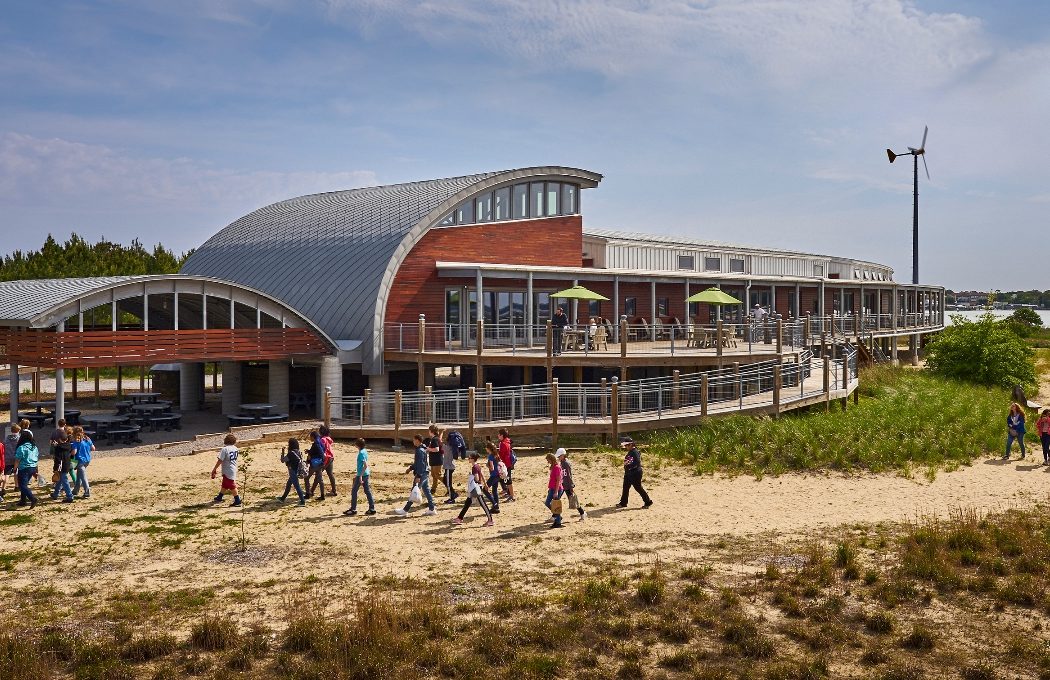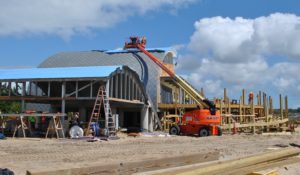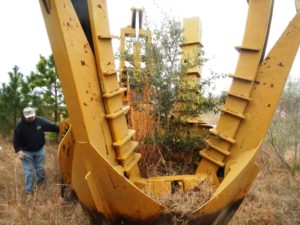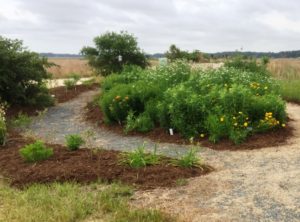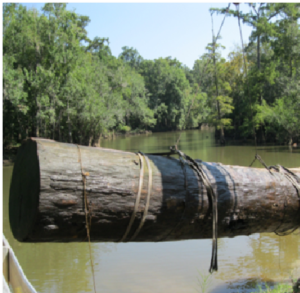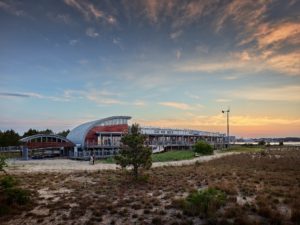On September 1, 2017, the Chesapeake Bay Foundation (CBF), which has long been leading the effort to restore Chesapeake Bay, celebrated their 50th anniversary with a community event.
At this time, it’s fitting that REVITALIZATION should help them celebrate by featuring their Hampton Roads, Virginia office building, which might be the most energy efficient, environmentally responsible, and ecologically restorative building in the world.
Opened in 2015, it’s called the Brock Environmental Center, and it’s located at Pleasure House Point in Virginia Beach, Virginia.
The anniversary celebration featured beer made out of rainwater collected at the Brock Center by Pleasure House Brewing. It is the only brewery in Virginia to produce beer from rainwater (and one of very few in the US).
With its restorative landscaping, reuse of salvaged building materials, solar panels, wind turbines, geothermal wells, rain cisterns, and waterless toilets, the center is an international model for energy and water efficiency. Elevated almost 14 feet above sea level, it is also a prototype for coping with climate change in a region increasingly prone to flooding.
The Brock Environmental Center was designed to gain the U.S. Green Building Council’s LEED Platinum designation and to meet the strict standards of the Living Building Challenge.
One requirement of these stringent sustainability standards is to use as many recycled or salvaged construction materials as possible. As any good environmentalists will tell you, reuse is almost always preferable to recycling (which is very energy-intensive). Fortunately, the Hampton Roads’ community has been very generous in supplying reusable items for the center. From local schools and governments to businesses and private citizens, those contributing the salvaged materials for the Brock Environmental Center reflect the community ideal the facility seeks to embrace.
For instance, art tables from the former Virginia Beach Old Donation Center School have a new life as counter tops in the center’s copy room. Storage cabinets and storage shelves from that school have found a new home in the lobby closet. The butcher block island in the center’s warming kitchen also is from the Old Donation Center. Lockers at the old Kellam High School in Virginia Beach get a new life in the staff shower and locker room.
Throughout the building, trim for windows, doors jams, and floorboards may look familiar to local residents: they are all milled from reclaimed bleachers in Virginia Beach’s Salem Middle School that were scheduled for replacement. In summer 2013, CBF staff and volunteers battled heat and old bubble gum to dismantle the bleachers and save them from the landfill.
The former Campostella Elementary School in nearby Norfolk was the source for nearly all of the maple floors in the center; in summer 2014, CBF retrieved nearly 4,000-square-feet of flooring that was slated to be removed and sent to the landfill.
But it’s not just about the building of course. As one might expect from an organization focused on environmental restoration, the property itself was ecologically revived. Here are some of the elements of the Brock’s restorative landscaping:
- Six different rain gardens and bioswales have been installed around the property using all native plants. These hold and filter runoff from the building and surrounding areas before it reaches the river.
- The Libby Norris Memorial Garden next to the Brock Center is a restoration garden of native trees, shrubs, and flowers that has become a meeting place and teaching tool for the community.
- Marsh grass along the river’s shoreline has been planted and restored by local students under a program run by CBF’s partner organization, Lynnhaven River NOW.
- They restored local dune grasses, including coastal panic grass, in the area between the Brock Center and the river with seed collected on site and planted by local school children.
- Live oaks in the building’s footprint were relocated to other areas on the property before construction began.
The Libby Norris Memorial Garden was named in loving memory of Libby Norris, CBF’s Virginia Watershed Restoration Scientist. Libby devoted her career to restoring clean water, planting thousands of native plants along streams, rivers, and the Chesapeake Bay. She dedicated her life to being a kind and generous wife, mother, and colleague, a friend to all she met.
Libby was also a friend to Virginia’s farmers, who farmers need bees, butterflies, birds, and bats to pollinate their crops. So, all the plants in Libby’s Garden were chosen to attract pollinators. The native plants also provide food and shelter for wildlife, while helping protect the Chesapeake Bay from pollution. The garden is encircled by three live oaks, two red oaks and a persimmon tree, which will eventually provide shade for visitors. The following native plants can be found in the Libby Garden:
- Arrowwood viburnum (Viburnum dentatum)
- Low bush blueberry (Vaccinium pallidum)
- Yellow wild indigo (Baptisia tinctoria)
- Virginia mountain mint (Pycnanthemum virginianum)
- Spotted bee balm (Monarda punctate)
- Butterfly weed (Asclepia tuberosa)
- Black-eyed Susan (Rudibeckia hirta)
- Oxeye sunflowers (Heliopsis helianthoides)
- Purple Dome aster (Aster novae-angliae)
- Grass leaf blazing star (Liatris pilosa var pilosa)
- Lanceleaf coreopsis (Coreopsis lanceolate)
- Moonbeam coreopsis (Coreopsis verticillata)
- Seaside goldenrod (Solidago sempervirens)
- Slender goldenrod (Solidago tenuifolia)
- Blackhaw viburnum (Viburnum prunifolium)
Elsewhere on the property, the following native plants were reintroduced: Swamp milkweed (Asclepias incarnate), Yaupon holly (Ilex vomitoria), Wax myrtle (Myrica cerifera), Redbay (Persea borbonia), and Swamp Bay (Persea palustris).
One of the most unusual feats of materials reuse was the “sinker cypress” logs recovered from rivers and bayous in the Deep South. The logs are first-growth cypress trees—some of them 500 to 1000 years old—that were cut down over a century ago. They were lost when they fell off barges, and sank on the way to Southern sawmills. The recovered logs now form the beautiful, weather-proof exterior siding of the Brock building.
It’s not just the large components that were reused, either. CBF partnered with citizens and several local schools and businesses, including Cape Henry Collegiate School, Norfolk Academy, Taste Unlimited, Starbucks, and Whole Foods Market, to set up collection bins throughout the Hampton Roads area for citizens to drop off champagne bottle corks. The corks were reused as knobs for desk and cabinet drawers in the Brock Environmental Center.
But earning a LEED Platinum designation wasn’t enough for CBF. In May of 2016, the Brock Environmental Center also achieved one of the toughest building standards in the world: the Living Building Challenge certification. With its solar panels and residential wind turbines producing nearly twice as much energy as the building has used, the Center has far surpassed expectations since its completion in late 2014. Built to be beautiful as well as environmentally friendly, the Brock Center is also the first commercial building in the continental United States permitted to capture and treat rainfall for use as drinking water.
“We’re extremely honored to receive Living Building Challenge certification,” said CBF President Will Baker. “At the Brock Center, we set out to show that a building can have remarkable benefits for both the environment and the community. Now it’s a proven concept. All of us have the choice to be sustainable in how we build.”
Living Building Challenge certification from the International Living Future Institute requires a building to produce more energy than it uses over the course of 12 consecutive months and meet a host of other strict criteria for water use, location, health, materials, equity, and beauty. The Brock Center completed its yearlong evaluation period in April.
“The Brock Environmental Center is extraordinary in its achievement of the Living Building Challenge, having met all of the criteria after demonstrating a year of performance,” said Amanda Sturgeon, CEO of the International Living Future Institute. “Pushing the envelope with living buildings like the Brock Center is key to creating a truly sustainable future.”
The results have been remarkable. Electrical hook-up fees for the 10,500 square foot building add up to only about $17.19 per month, the minimum fee to tie into the grid. In fact, in the past year the Center has produced about 83 percent more energy than it has used. The building also uses 90 percent less water than a typical office building of its size. And as a result of conservation efforts and innovative technologies, the building uses 80 percent less energy than a typical building that size.
“The Brock Center has become a game-changing teaching tool. People are eagerly learning that it is possible for each of us to make a difference and reverse our negative impact on the natural environment,” said CBF Vice President of Administration Mary Tod Winchester. “When you visit the Brock Center, it will provide you with at least one take away for how you can give back to our environment.”
The Brock Center is open to the public for tours. Located at Pleasure House Point, the building houses CBF’s Hampton Roads staff and that of Lynnhaven River NOW, a Virginia Beach watershed organization. It also houses CBF’s award-winning environmental education programs in Hampton Roads and features meeting space for community discussions and collaboration. Partnering with CBF to create the center were SmithGroupJJR, Hourigan Construction, Skanska, WPL Site Design, and J. Harrison, Architect.
The Center is named in honor of Joan and Macon Brock of Virginia Beach, who generously provided a $3.6 million leadership gift toward the $21 million project.
Unless otherwise credited, all photos are by Prakash Patel/SmithGroupJJR.
See timeline of the 10-year process of creating the Brock building.

